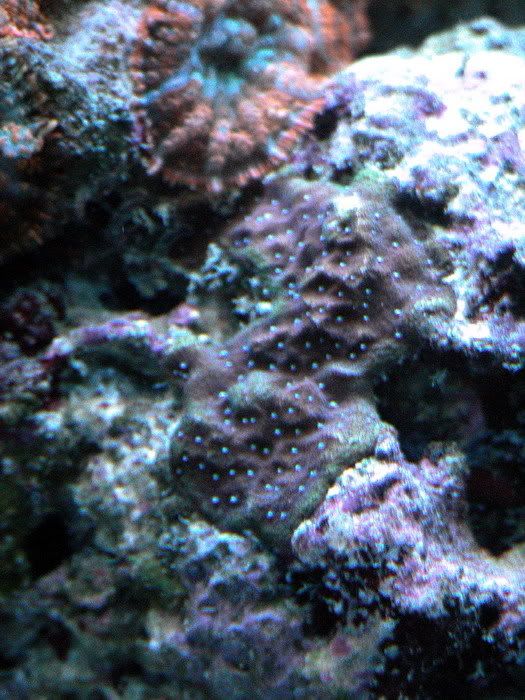

|
|
|
#1
|
|||
|
|||
|
What in tarnation is this?
I've posted in Reef Discussion without any definite ID. It's kind of interesting because of the change it has recently gone through. Unfortunately I don't have a photo of what it had looked like for over a year since it came into my reef on live rock, BUT here's what it looks like now:
 Up until about one week ago, it looked the same as it had since I first saw it as something growing on the live rock. It was a much darker, deeper red color and the spots on it were much dimmer, though apparent. The surface of this appeared to be smooth. I'm not at all certain what might have prompted it to change so radically in the last week, but I did move a piece of rock above it which exposed it a little more to light than it had been. I did change over from PCs to MHs about 5 months ago and that did expose it to more brightness but that change-over had no effect on this. In any event, now, its color had muted from the deep red to this brownish-red with green high-lights. Also, this "hair-like" appearance has become very obvious and it is growing. It was consistently about an inch and a half from top to bottom and an inch wide but it's grown a bit (maybe a 1/4 inch) for the first time since I've had it, in the last week. It never occurred to me that this was a coral but now it has taken on some clear indications of that. The white spots, which are now much whiter than they had been all along are baffling to me. Any idea what it might be?
__________________
Most people get results...I seem to have consequences |
|
#2
|
|||
|
|||
|
So no one's seen this before?
__________________
Most people get results...I seem to have consequences |
|
#3
|
|||
|
|||
|
Tooo fuzzy and cannot see the skeleton. sorry - nice coral, though!
__________________
Eric Borneman |
|
#4
|
|||
|
|||
|
Eric...I'll try to take a clearer photo tomorrow, though this one is actually fairly clear...this thing is fuzzy. There doesn't seem to be any skeleton and it's, at least from what it looks like, growing on the surface of the live rock, though there isn't a clear encrustation like what you'd see with green star polyps or braereum. Is there anything else I could describe for you that would help with an ID?
__________________
Most people get results...I seem to have consequences |
|
#5
|
|||
|
|||
|
After placing my finger on this it did show retraction. I'm working on some more closeup shots, but the glass being so close in front of the coral makes it difficult to focus on it in a macro format.
You can see that the white dots are raised.  Here it is after it was touched...... 
__________________
Most people get results...I seem to have consequences |
|
#6
|
|||
|
|||
|
Really neat coral
 Lookin foward to finding out what it is Lookin foward to finding out what it is  -Justin |
|
#7
|
|||
|
|||
|
were you able to find out what it was Avi?
-Justin |
|
#8
|
|||
|
|||
|
No, I actually wasn't able to get anything more than vague guesses...I'll take another photo later on and get it posted here.
__________________
Most people get results...I seem to have consequences |
|
#9
|
|||
|
|||
|
This hasn't changed much, but some growth has occurred on the upper left end of it:

__________________
Most people get results...I seem to have consequences |
|
#10
|
|||
|
|||
|
Looks a little like an encrusting pavona?????
__________________
OOOOOOOKKKKKKKKKK!!! |
|
#11
|
|||
|
|||
|
My guess.....Psammocora Superficialis
|
|
#12
|
|||
|
|||
|
Psammacora is a possibility,so is Coscinarea as are others in Agariciidae - you cannot see the skeleton, so it is not possible for me to see if the corallites are petaloid, or any features necessary to determine what this coral might be.
Jennsb - ever looked at a Psammacora species under a dissecting scope? Try it some time. Tell you what...let me post a photo of two species of Psammacora....you tell me which is which.
__________________
Eric Borneman |
|
#13
|
|||
|
|||
|
Psammacora 1
Psammacora 2 I find Psammacora to be among the most difficult to identify corals to species. The oramentation of the septa and even distinguishing where corallites start and end is a chore. Clearly, there is no way to see the features from the photos in the post.
__________________
Eric Borneman |
|
#14
|
|||
|
|||
|
By the way...one of them, perhaps both, are Psammacora superficialis. Even after several hours of examination of individual species, I still couldn't tell you for sure. It took a team of three coral scientists and myself looking at three colllected samples and a museum specimen to reach a somewhat confident determination that what we had collected was P superficialis.
__________________
Eric Borneman |
|
#15
|
|||
|
|||
|
And here is the living colony
and the living sample of the colony out of water
__________________
Eric Borneman |
|
#16
|
|||
|
|||
|
You've commented a few times about the inadequacy of the photos posted above and I would be happy to accomodate you, if I could, with some other photos...BUT....I just again, for the thousandth time...looked at this coral and the photo is right on. Yep, right on. It shows precisely what it looks like. If there is something that you're getting at as far as a fair and accurate representation of this thing that the photo isn't providing, please let me know, and I'll try to get it for you. The ONLY things that don't appear in the photos that are now more apparent in looking directly at the coral itself are little dots in the centers of the white dots that are plainly seen in the posted photos. Also, it has spread a little bit since the posted photos were taken. I will post new photos in a day or two after I take care of some operating system problems that I'm having.
__________________
Most people get results...I seem to have consequences |
|
#17
|
|||
|
|||
|
Avi, your photos are great, but short of killing a piece of it, bleaching it, and sending me the skeleton, I cannot tell you what coral you have. Even then, it could be very difficult. I cannot tell enough about it without seeing the skeleton.
__________________
Eric Borneman |
|
#18
|
|||
|
|||
|
I see, now, what the difficulty is, Eric. Regarding the skeleton of this coral, the only thing I might add is that it must be very shallow because looking at it, it appears not to have any appreciable "depth" at all from the rock that it's growing on. Indeed, it takes on the "topography" of the rock very closely.
At any rate, thanks very much for your efforts...I'll continue to be intrigued by this and chalk up its identity to it being a mystery of the "sea."
__________________
Most people get results...I seem to have consequences |
|
#19
|
|||
|
|||
|
i have the exact same coral in my tank, came in as a hitchhiker on some zooanthids on scleractinia, and has green mouths. from the glimpses of he skeleton ive seen it looks fairly sinuous kinda like merulina.
__________________
...skip I speak for myself and no one else. |
|
#20
|
|||
|
|||
|
pyrrhus...I have merulina in my reef bit there is no "hairy" appearance to it as the coral in question does. Can you pose a photo of the similar hitchhiker that you have?
__________________
Most people get results...I seem to have consequences |
|
#21
|
|||
|
|||
|
pyrrhus - the exact same coral???!!!! How did you get "glimpses" of the skeleton? Tissue peel away?
Avi then asks to post a photo. What part of this thread do you guys not get? You cannot ID this coral from a photo. It is NOT Merulina.
__________________
Eric Borneman |
|
#22
|
|||
|
|||
|
Eric...I just asked for a photo out of curiosity, since I never saw another of these. I didn't ask for it because I thought I could identify it from one after what you said. You aren't the thought police because you wrote a book, are you? Calm down. We aren't ignoring what you said. Wow.
__________________
Most people get results...I seem to have consequences |
|
#23
|
|||
|
|||
|
I wasnt implying that it was merulina just that I saw a glimpse of the skeleton through transparent tissue when i first acquired this coral, it has since colored in that area and the skeleton is now obscured. it may not be the exact same coral but that is about as close as i have seen of any coral around.
sorry for the quality but heres a pic.[IMG] http://reefcentral.com/gallery/data/...tery_coral.JPG[/IMG] Eric, i also have a photo of Blastomussa wellsi undergoing polyp extrusion (as i understand the term) if you are interested.
__________________
...skip I speak for myself and no one else. |
|
#24
|
|||
|
|||
|
pyrrhus, that certainly does look similar. Are the dots, which mouths (dots) green in your's case? They are white on the one that I have.
__________________
Most people get results...I seem to have consequences |
|
#25
|
|||
|
|||
|
no, I'm not upset, but a little frustrated when trying to show how the coral is very hard to ID, and then the post about having the "exact same coral" when we have no idea what this one is...a better way to put it is that I have a coral that has a similar appearance. Either of you are more than welcome to do what Will is doing in the other thread...break off a little bit, put it in household bleach for a day till all the tissue is dissolved, making sure to geta "represnetative part" (can be very small), then flush the corallites well with a jet of water but not so hard as to break any septa, and send it to me. Be happy to try and ID it for you.
pyrrhus - yes, would be very interested in seeing the Blastomussa extrusion.
__________________
Eric Borneman |
|
|